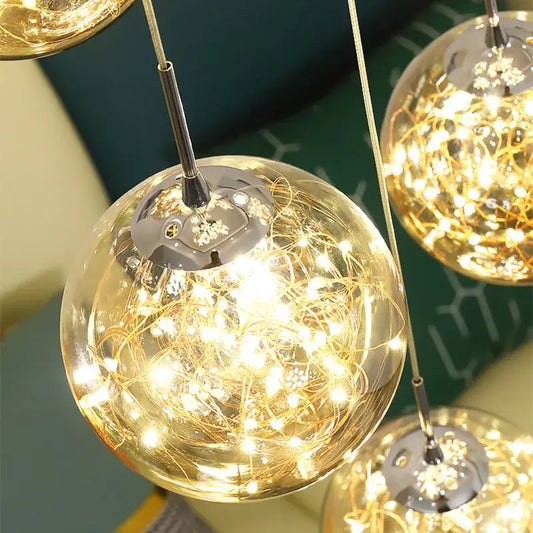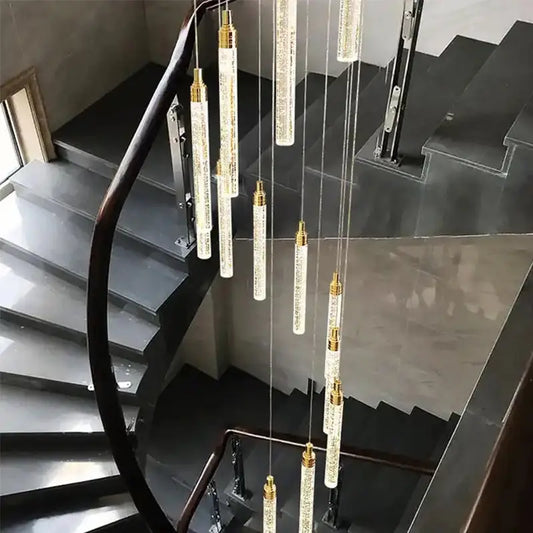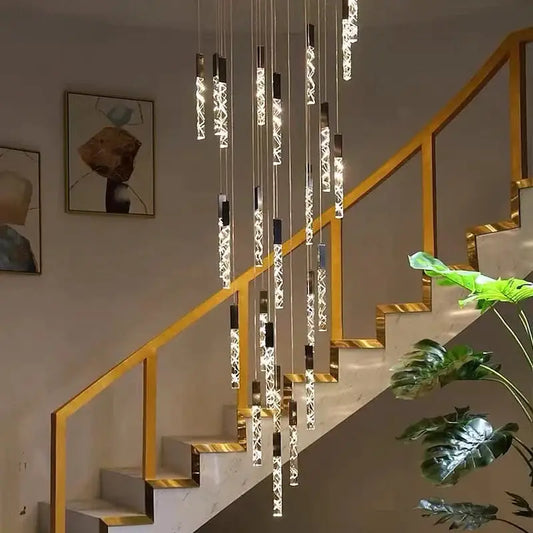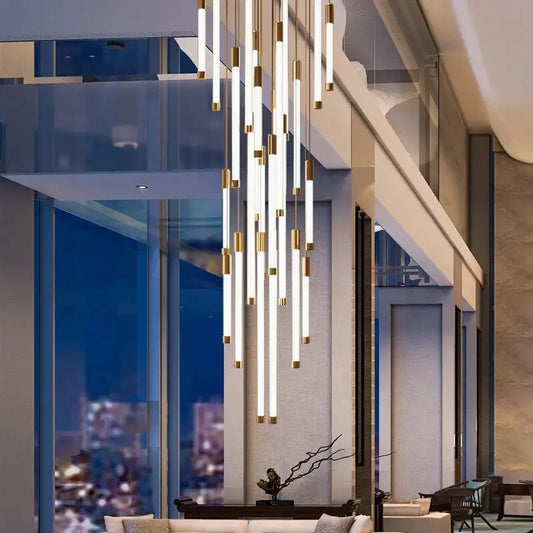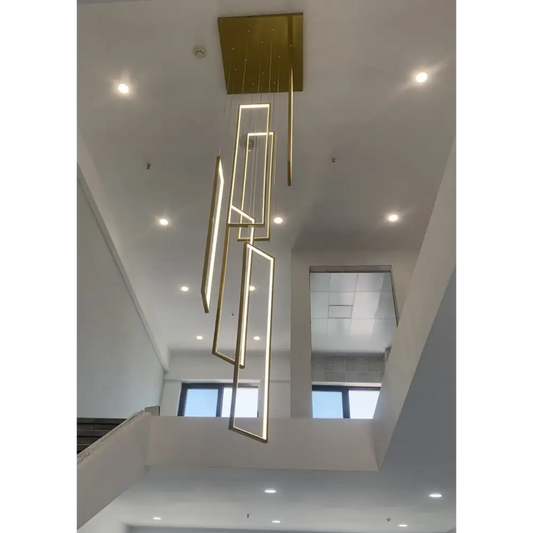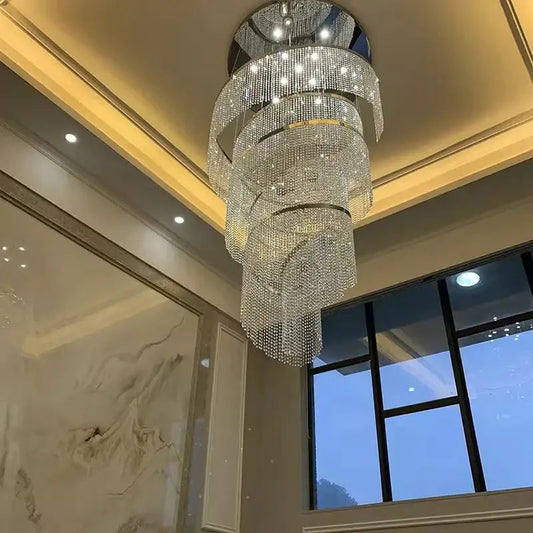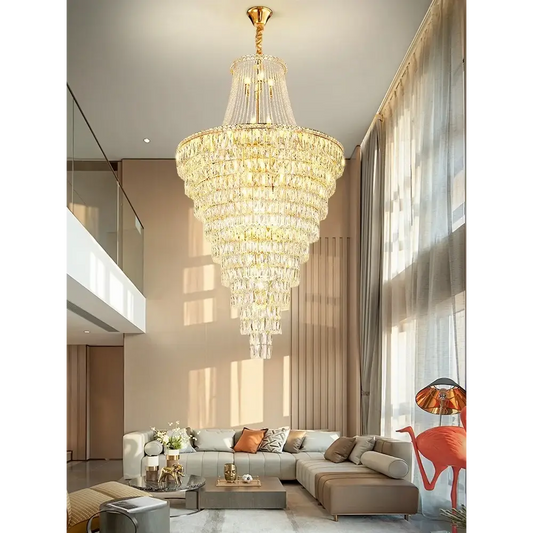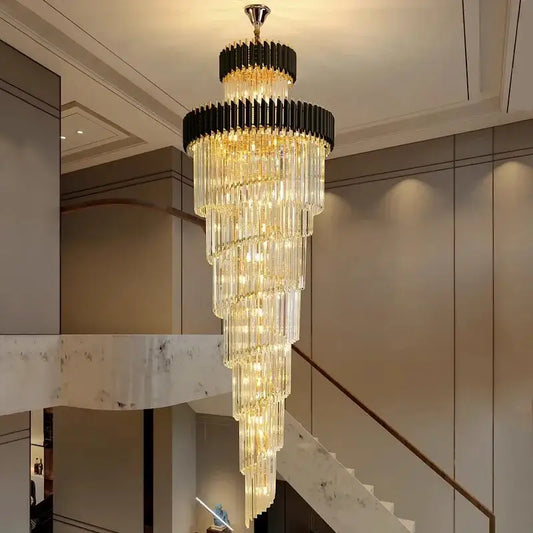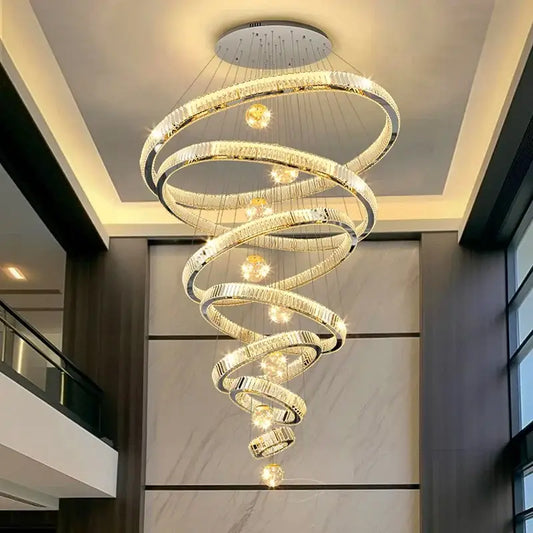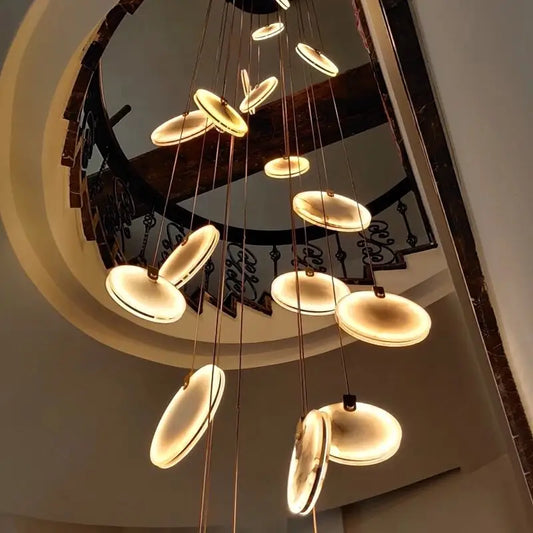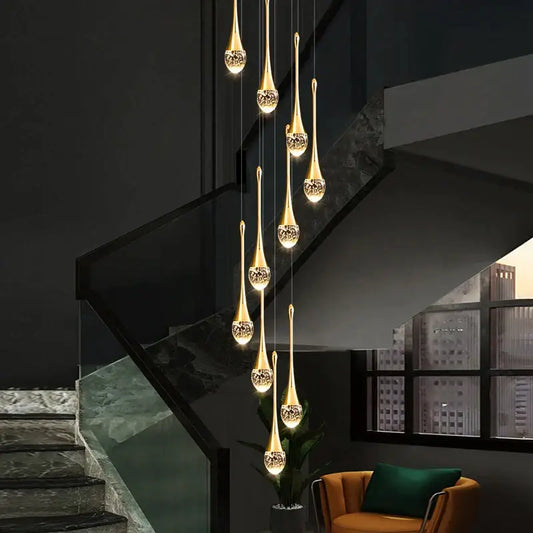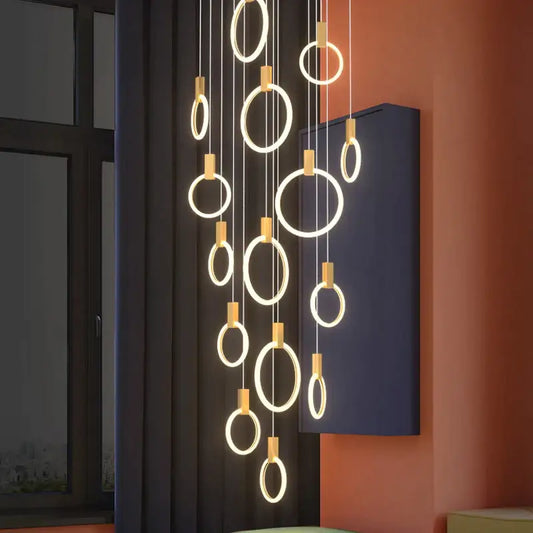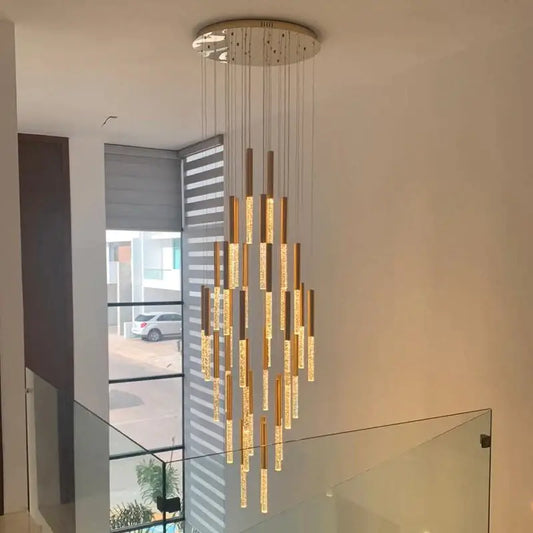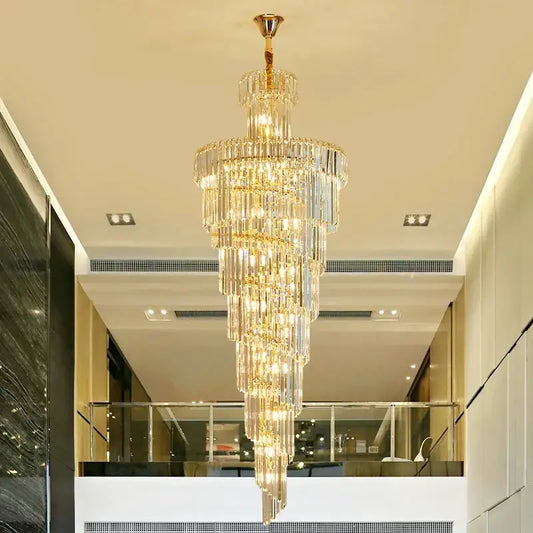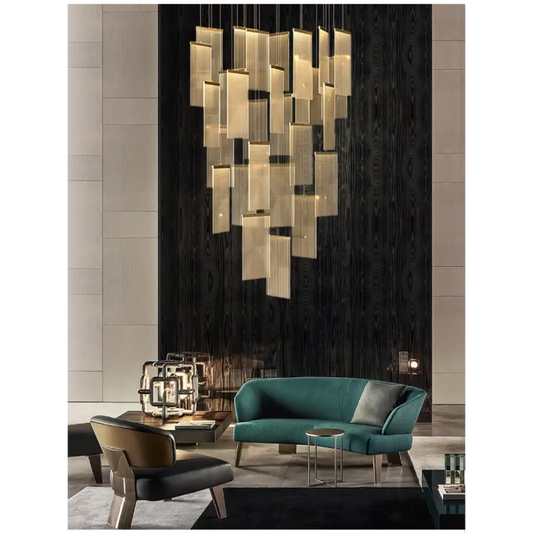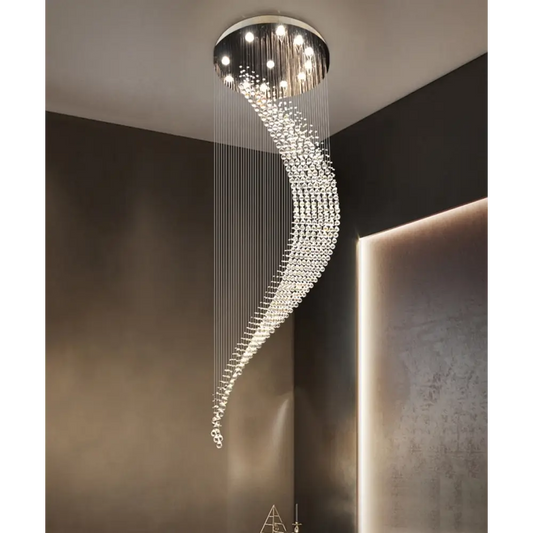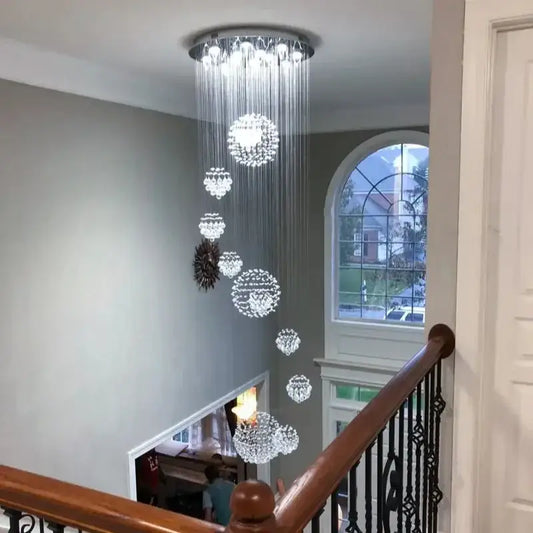Collection: Staircase Chandelier
-
Modern Glass Ball Dimmable Chandelier for Staircase
5.0 / 5.0
(10) 10 total reviews
Regular price From $293.80 USDRegular priceUnit price / per$0.00 USDSale price From $293.80 USD -
Shimmering Spiral Gold Crystal Chandelier
Regular price From $91.52 USDRegular priceUnit price / per$0.00 USDSale price From $91.52 USD -
Luxury Hanging Long-Led Staircase Chandelier for Living, Hall
4.95 / 5.0
(20) 20 total reviews
Regular price From $143.14 USDRegular priceUnit price / per$0.00 USDSale price From $143.14 USD -
Luxury Long Led Strip Chandelier for Staircase, Living, Foyer
5.0 / 5.0
(9) 9 total reviews
Regular price From $327.25 USDRegular priceUnit price / per$0.00 USDSale price From $327.25 USD -
Modern Rectangle LED Chandelier for Staircase, Lobby, Living
5.0 / 5.0
(3) 3 total reviews
Regular price From $611.12 USDRegular priceUnit price / per -
Diamond Crystal Ball Chandelier for Staircase, Living Room
5.0 / 5.0
(4) 4 total reviews
Regular price From $455.40 USDRegular priceUnit price / per$0.00 USDSale price From $455.40 USD -
Luxury Large Spiral Crystal Chandelier for Staircase, Hallway
Regular price From $1,619.68 USDRegular priceUnit price / per$0.00 USDSale price From $1,619.68 USD -
Golden Luxurious Multi-Story Staircase Crystal Chandelier
5.0 / 5.0
(4) 4 total reviews
Regular price From $777.82 USDRegular priceUnit price / per -
Long Black Luxury Crystal Chandelier for Staircase, Lobby
5.0 / 5.0
(1) 1 total reviews
Regular price From $1,768.30 USDRegular priceUnit price / per$0.00 USDSale price From $1,768.30 USD -
Luxury Round Crystal Chandelier for Staircase, Loft, Living
5.0 / 5.0
(2) 2 total reviews
Regular price From $919.23 USDRegular priceUnit price / per$0.00 USDSale price From $919.23 USD -
Nordic Crystal Chandelier - Adjustable Rings
5.0 / 5.0
(11) 11 total reviews
Regular price From $391.98 USDRegular priceUnit price / per -
Luxury Long Marble Chandelier for Staircase, Lobby, Hallway
5.0 / 5.0
(1) 1 total reviews
Regular price From $688.38 USDRegular priceUnit price / per$0.00 USDSale price From $688.38 USD -
Luxury Water-Drop Spiral Crystal Chandelier for Staircase,Hallway
5.0 / 5.0
(6) 6 total reviews
Regular price From $682.88 USDRegular priceUnit price / per$0.00 USDSale price From $682.88 USD -
Luxury Round Hanging Acrylic Chandelier for Staircase, Living
5.0 / 5.0
(1) 1 total reviews
Regular price From $421.75 USDRegular priceUnit price / per -
Luxury Long Hanging Spiral Chandelier for Staircase, Lobby, Hall
5.0 / 5.0
(1) 1 total reviews
Regular price From $357.00 USDRegular priceUnit price / per$0.00 USDSale price From $357.00 USD -
Luxury Large Gold Crystal Chandelier for Staircase, Loft
5.0 / 5.0
(4) 4 total reviews
Regular price From $2,085.53 USDRegular priceUnit price / per$0.00 USDSale price From $2,085.53 USD -
Luxury Long Spira Crystal Chandelier for Staircase, Hall, Living
Regular price From $2,346.44 USDRegular priceUnit price / per$0.00 USDSale price From $2,346.44 USD -
Luxury Modern LED Chandelier for Staircase, Living, Lobby
5.0 / 5.0
(1) 1 total reviews
Regular price From $600.85 USDRegular priceUnit price / per$800.68 USDSale price From $600.85 USDSale -
Spiral Moon Chandelier for Duplex Staircase, Lobby, Hall, Stairwell
Regular price From $383.21 USDRegular priceUnit price / per$511.20 USDSale price From $383.21 USDSale -
Spiral Raindrop Crystal Ball LED Staircase Chandelier
Regular price From $419.80 USDRegular priceUnit price / per
Collapsible content
Staircase Chandeliers Collection
Do you want to add a touch of elegance and drama to your staircase? Then you need a staircase chandelier from Toplightstore. A staircase chandelier is a chandelier that is designed to hang over a staircase, creating a stunning focal point and a beautiful illumination. A staircase chandelier can transform your staircase into a glamorous and inviting space, as it reflects the light and the movement of the stairs. A staircase chandelier can also enhance the style and value of your home, as it comes in various shapes, sizes, colors, and features to suit your taste and decor. Whether you want a classic crystal chandelier, a modern metal chandelier, or a unique glass chandelier, we have it all at Toplightstore. Browse our staircase chandelier collection today and find your dream chandelier. Order now and get a 20% discount on your first order.
FAQs of Staircase Chandelier
How big should a chandelier be over a staircase?
The size of the chandelier that you need over a staircase depends on several factors, such as the height, width, and length of the staircase, the ceiling height, and the style and design of the chandelier. However, a general rule of thumb is to measure the height of the staircase in feet and multiply by 2.5 to 3. The result is the approximate diameter of the chandelier that you need in inches. For example, if your staircase is 10 feet high, you need a chandelier with a diameter of about 25 to 30 inches. However, this is only a rough estimate and you should also consider other factors, such as the shape and layout of the staircase, the number and location of the chandelier, and the clearance and safety requirements.
How do I choose a stairwell chandelier?
To choose a stairwell chandelier, you should consider the following factors:
- The style and theme of your home, as the chandelier should match your home decor and personality. You can choose a chandelier that complements or contrasts your home style, such as a classic, modern, rustic, or eclectic chandelier.
- The shape and size of your staircase, as the chandelier should fit your staircase space and height comfortably and safely. You can choose a chandelier that follows or contrasts the shape of your staircase, such as a round, square, oval, or rectangular chandelier.
- The lighting and function of your staircase, as the chandelier should provide enough illumination and ambiance for your staircase. You can choose a chandelier that has the features and functions that you want, such as dimmable, adjustable, or remote-controlled chandelier.
- The budget and maintenance of your chandelier, as the chandelier should be affordable and easy to install, clean, and repair. You can choose a chandelier that has the materials and quality that you can afford and maintain, such as crystal, metal, glass, or wood chandelier.
How low should the staircase chandelier hang?
The height at which you should hang your staircase chandelier depends on several factors, such as the ceiling height, the staircase height, the chandelier size, and the style and design of the chandelier. However, a general guideline to follow is to hang your chandelier at least 7 feet above the floor or the highest point of the staircase, whichever is higher. This is to ensure that the chandelier does not obstruct the view or the movement of the staircase, and also to create a balanced and proportional look. However, this is only a general guideline and you should also consider other factors, such as the shape and layout of the staircase, the number and location of the chandelier, and your personal preference and comfort.
What lights are best for stairwells?
The best lights for stairwells are the ones that provide enough illumination and safety for the stairwells but also enhance the beauty and value of the stairwells. The best lights for stairwells depend on several factors, such as the size, shape, and style of the stairwells, the ceiling height, and the lighting needs and preferences. However, some common types of lights that are suitable for stairwells are:
- Chandeliers: Chandeliers are lights that hang from the ceiling and have multiple branches or arms that hold bulbs or candles. Chandeliers are ideal for stairwells that have high ceilings and large spaces, as they can create a stunning focal point and a beautiful illumination. Chandeliers can also enhance the style and theme of the stairwells, as they come in various shapes, sizes, colors, and features to suit different tastes and decors.
- Pendants: Pendants are lights that hang from the ceiling and have a single cord or chain that holds a bulb or a shade. Pendants are ideal for stairwells that have low ceilings and small spaces, as they can create a simple and elegant look and a focused illumination. Pendants can also enhance the shape and size of the stairwells, as they come in different shapes, sizes, colors, and features to suit different spaces and layouts.
- Recessed: Recessed lights are lights that are installed into the ceiling and have a trim that covers the hole and holds the bulb. Recessed lights are ideal for stairwells that have any ceiling height and space, as they can create a clean and modern look and uniform illumination. Recessed lights can also enhance the function and safety of the stairwells, as they can provide enough light and visibility for the stairs, and also avoid glare and shadows.
- Wall Sconces: Wall sconces are lights that are mounted on the wall and have a base that holds a bulb or a shade. Wall sconces are ideal for stairwells that have any ceiling height and space, as they can create a cozy and warm look and a soft illumination. Wall sconces can also enhance the mood and ambiance of the stairwells, as they can provide decorative and accent lighting for the walls, and also create a contrast and depth for the stairs.
- Step Lights: Step lights are lights that are installed into the steps or the risers of the stairs and have a cover that protects the bulb. Step lights are ideal for stairwells that have any ceiling height and space, as they can create a sleek and futuristic look and subtle illumination. Step lights can also enhance the safety and visibility of the stairwells, as they can provide a guide and a marker for the stairs, and also avoid tripping and falling.
What kind of light do you use in a stairwell?
The kind of light that you use in a stairwell depends on several factors, such as the size, shape, and style of the stairwell, the ceiling height, and the lighting needs and preferences. However, some common kinds of light that are used in stairwells are:
- LED: LED lights are lights that use light-emitting diodes (LEDs) as the source of light. LED lights are ideal for stairwells, as they are energy-efficient, long-lasting, bright, and versatile. LED lights can also provide different colors, temperatures, and effects for the stairwells, as they can be dimmable, adjustable, or remote-controlled.
- Halogen: Halogen lights are lights that use halogen gas as the source of light. Halogen lights are ideal for stairwells, as they are bright, clear, and natural. Halogen lights can also provide a warm and cozy atmosphere for the stairwells, as they have a yellowish-white color and a soft glow.
- Fluorescent: Fluorescent lights are lights that use mercury vapor as the source of light. Fluorescent lights are ideal for stairwells, as they are economical, durable, and cool. Fluorescent lights can also provide a bright and uniform illumination for the stairwells, as they have a white or bluish-white color and a wide beam.
- Incandescent: Incandescent lights are lights that use a filament as the source of light. Incandescent lights are ideal for stairwells, as they are cheap, easy to install, and familiar. Incandescent lights can also provide a classic and elegant look for the stairwells, as they have a yellowish-orange color and a warm glow.
How do you light a stairwell?
To light a stairwell, you need to consider the following steps:
- Determine the size, shape, and style of your stairwell, as it will affect the type, number, and location of the lights that you need.
- Choose the type of light that you want to use, such as chandeliers, pendants, recessed, wall sconces, or step lights, depending on your ceiling height, space, and preference.
- Choose the kind of light that you want to use, such as LED, halogen, fluorescent, or incandescent, depending on your budget, efficiency, and mood.
- Choose the color, temperature, and effect of the light that you want to use, such as warm, cool, neutral, dimmable, adjustable, or remote.
Where do you put lights on the stairs?
You can put lights on stairs in various ways, depending on the design and purpose of the lighting. Some common ways are:
- On the ceiling: You can install recessed lights, flush mount lights, or pendant lights on the ceiling above the stairs, to provide general or ambient lighting.
- On the wall: You can install wall sconces, picture lights, or track lights on the wall along the stairs, to provide accent or task lighting.
- On the stair risers: You can install LED strip lights, rope lights, or puck lights on the stair risers, to provide safety or decorative lighting.
- On the stair treads: You can install LED step lights, motion sensor lights, or solar lights on the stair treads, to provide safety or eco-friendly lighting.
Where do you put stair lights?
Stair lights are usually installed on the stair risers or treads, to provide safety and visibility for the users. You can also put stair lights on the wall or ceiling, to create a more dramatic or artistic effect. The location of the stair lights will depend on the type, size, and shape of the lights, as well as the wiring and installation requirements.
Is a chandelier too big for a foyer?
A chandelier can be too big for a foyer if it is disproportionate to the size and height of the space, or if it obstructs the view or movement of the people. A general rule of thumb is to choose a chandelier that is 1/3 to 1/2 of the width of the foyer and to hang it so that the bottom of the fixture is at least 7 feet above the floor. You can also measure the length and width of the foyer in feet, add them together, and use the sum in inches as the diameter of the chandelier.
How do you make a stairwell look good?
There are many ways to make a stairwell look good, such as:
- Choosing the right lighting: You can use different types and styles of lights, such as chandeliers, pendant lights, wall sconces, recessed lights, and stair lights, to create a bright, cozy, or dramatic atmosphere.
- Adding some color: You can paint the walls, ceiling, or stairs in a color that matches or contrasts with the rest of the house or use wallpaper, decals, or murals to add some pattern and texture.
- Decorating the walls: You can hang some artwork, photos, mirrors, or shelves on the walls, to display your personality and style, or use some plants, flowers, or wreaths to add some freshness and greenery.
- Accessorizing the stairs: You can use some rugs, runners, or mats on the stairs, to add some comfort and warmth, or use some candles, lanterns, or vases on the stair landings, to add some charm and elegance.
How to decorate a stairwell safely?
To decorate a stairwell safely, you need to consider the following tips:
- Avoid clutter: You should avoid placing any objects or furniture that can block or trip the users, such as baskets, boxes, chairs, or tables.
- Secure the items: You should make sure that any items that you hang or place on the walls, ceiling, or stairs are firmly attached and stable, such as frames, hooks, nails, or screws.
- Choose the right size: You should choose the items that are appropriate for the size and shape of the stairwell, and that do not interfere with the lighting, ventilation, or visibility of the space.
- Follow the codes: You should follow the local building codes and regulations that apply to the stairwell, such as the minimum width, height, and clearance of the stairs, railings, and landings.
Can a chandelier be too heavy for the ceiling?
A chandelier can be too heavy for the ceiling if it exceeds the weight limit of the ceiling joists, the electrical box, or the mounting hardware. A typical ceiling can support up to 50 pounds of weight, but some chandeliers can weigh more than that, especially if they are large, ornate, or made of metal or crystal. If you want to install a heavy chandelier, you need to reinforce the ceiling structure, use a heavy-duty electrical box, and use appropriate screws and anchors.
Do you need a light on the staircase?
You need a light in the staircase for safety, convenience, and aesthetic reasons. A light in the staircase can help you see the steps clearly, avoid falls and injuries, and navigate the stairs easily. A light in the staircase can also enhance the appearance and ambiance of the stairwell, and create a focal point or a mood for the space.
What is a stair light?
A stair light is a type of light that is installed on or near the stairs, to provide illumination, safety, and decoration. There are different kinds of stair lights, such as:
- Stair riser lights: These are lights that are installed on the vertical part of the stairs, to highlight the steps and create a visual effect.
- Stair tread lights: These are lights that are installed on the horizontal part of the stairs, to mark the edges and provide visibility.
- Stair wall lights: These are lights that are installed on the wall along the stairs, to accentuate the architecture and design of the stairwell.
- Stair ceiling lights: These are lights that are installed on the ceiling above the stairs, to provide general or ambient lighting.
What are the advantages of staircase lighting?
Some of the advantages of staircase lighting are:
- It improves safety and security: It helps you see the steps, avoid falls and injuries, and deter intruders or burglars.
- It enhances convenience and comfort: It helps you navigate the stairs easily, especially at night or in low-light conditions, and adjust the brightness and color according to your preference.
- It adds beauty and style: It helps you create a focal point or a mood for the stairwell, and showcase your personality and taste.


